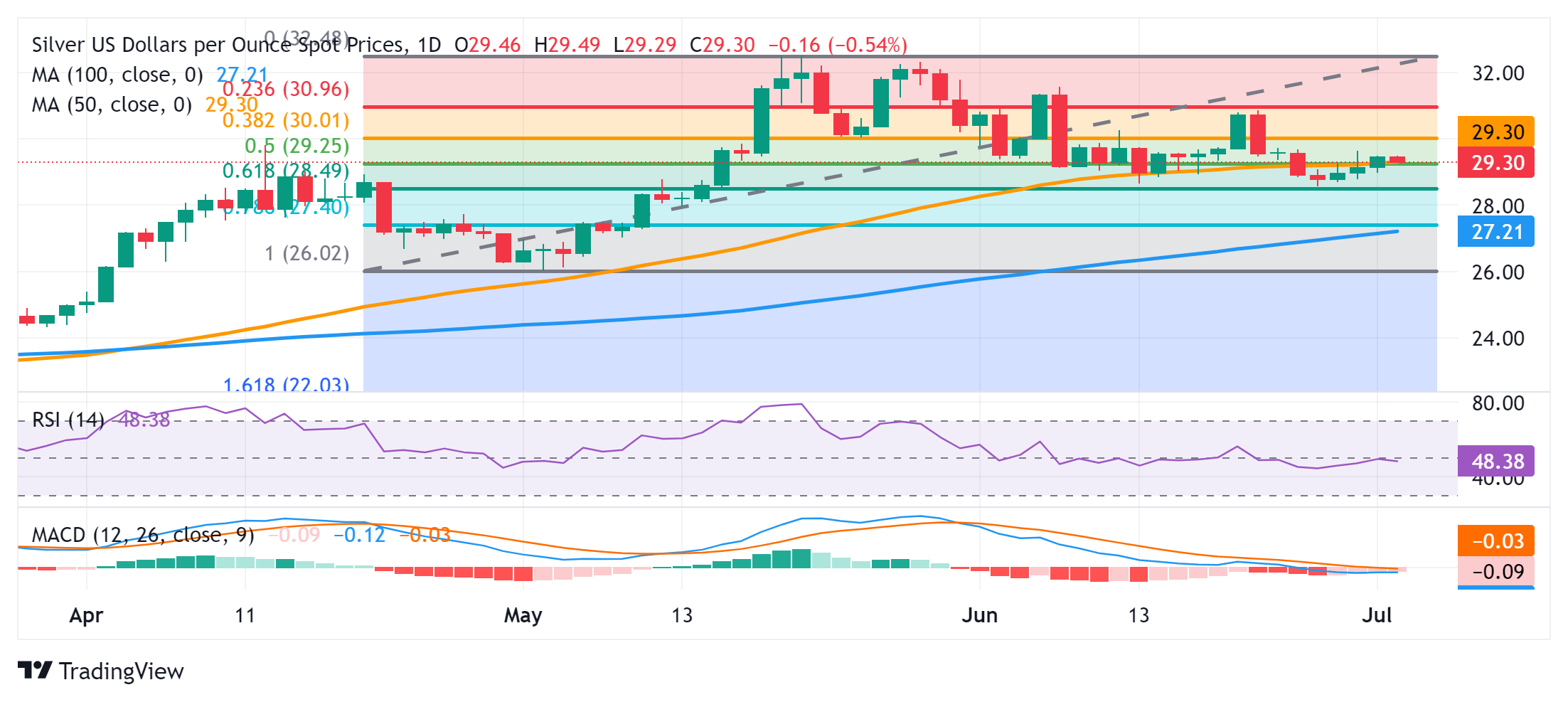- Silver drifts lower during the Asian session on Tuesday and snaps a three-day winning streak.
- The mixed technical setup warrants some caution before placing aggressive directional bets.
- A sustained strength beyond the $30.00 mark is needed to negate any near-term negative bias.
Silver (XAG/USD) struggles to capitalize on its modest gains registered over the past three days and attracts some sellers during the Asian session on Tuesday. The white metal currently trades around the $29.35-$29.30 area, down 0.45% for the day, and for now, seems to have stalled the recent recovery from its lowest level since mid-May touched last Wednesday.
From a technical perspective, last week's breakdown through the 50-day Simple Moving Average (SMA) was seen as a fresh trigger for bearish traders. That said, the subsequent bounce from the 61.8% Fibonacci retracement level of the $26.02-$32.51 rally and neutral oscillators on the daily chart warrant some caution before positioning for further losses.
In the meantime, the $29.55-$29.60 area is likely to act as an immediate hurdle ahead of the 38.2% Fibo. level, around the $30.00 psychological mark. A sustained strength beyond the latter will negate any near-term negative bias and lift the XAG/USD to the $31.00 neighborhood with some intermediate resistance near the $30.30-$30.35 supply zone.
On the flip side, the $29.00 round figure is likely to protect the immediate downside ahead of the $28.60-$28.55 region, or the 61.8% Fibo. level. A convincing break below has the potential to drag the XAG/USD towards the $28.00 mark. The downfall could extend further towards the $27.40-$27.30 confluence – comprising 78.6% Fibo. and the 100-day SMA.
Silver daily chart
Silver FAQs
Silver is a precious metal highly traded among investors. It has been historically used as a store of value and a medium of exchange. Although less popular than Gold, traders may turn to Silver to diversify their investment portfolio, for its intrinsic value or as a potential hedge during high-inflation periods. Investors can buy physical Silver, in coins or in bars, or trade it through vehicles such as Exchange Traded Funds, which track its price on international markets.
Silver prices can move due to a wide range of factors. Geopolitical instability or fears of a deep recession can make Silver price escalate due to its safe-haven status, although to a lesser extent than Gold's. As a yieldless asset, Silver tends to rise with lower interest rates. Its moves also depend on how the US Dollar (USD) behaves as the asset is priced in dollars (XAG/USD). A strong Dollar tends to keep the price of Silver at bay, whereas a weaker Dollar is likely to propel prices up. Other factors such as investment demand, mining supply – Silver is much more abundant than Gold – and recycling rates can also affect prices.
Silver is widely used in industry, particularly in sectors such as electronics or solar energy, as it has one of the highest electric conductivity of all metals – more than Copper and Gold. A surge in demand can increase prices, while a decline tends to lower them. Dynamics in the US, Chinese and Indian economies can also contribute to price swings: for the US and particularly China, their big industrial sectors use Silver in various processes; in India, consumers’ demand for the precious metal for jewellery also plays a key role in setting prices.
Silver prices tend to follow Gold's moves. When Gold prices rise, Silver typically follows suit, as their status as safe-haven assets is similar. The Gold/Silver ratio, which shows the number of ounces of Silver needed to equal the value of one ounce of Gold, may help to determine the relative valuation between both metals. Some investors may consider a high ratio as an indicator that Silver is undervalued, or Gold is overvalued. On the contrary, a low ratio might suggest that Gold is undervalued relative to Silver.
Information on these pages contains forward-looking statements that involve risks and uncertainties. Markets and instruments profiled on this page are for informational purposes only and should not in any way come across as a recommendation to buy or sell in these assets. You should do your own thorough research before making any investment decisions. FXStreet does not in any way guarantee that this information is free from mistakes, errors, or material misstatements. It also does not guarantee that this information is of a timely nature. Investing in Open Markets involves a great deal of risk, including the loss of all or a portion of your investment, as well as emotional distress. All risks, losses and costs associated with investing, including total loss of principal, are your responsibility. The views and opinions expressed in this article are those of the authors and do not necessarily reflect the official policy or position of FXStreet nor its advertisers. The author will not be held responsible for information that is found at the end of links posted on this page.
If not otherwise explicitly mentioned in the body of the article, at the time of writing, the author has no position in any stock mentioned in this article and no business relationship with any company mentioned. The author has not received compensation for writing this article, other than from FXStreet.
FXStreet and the author do not provide personalized recommendations. The author makes no representations as to the accuracy, completeness, or suitability of this information. FXStreet and the author will not be liable for any errors, omissions or any losses, injuries or damages arising from this information and its display or use. Errors and omissions excepted.
The author and FXStreet are not registered investment advisors and nothing in this article is intended to be investment advice.
Recommended content
Editors’ Picks

EUR/USD holds steady near 1.0300 ahead of EU/ German data
EUR/USD eases to near 1.0300 in the early European session on Monday. A softer risk tone offsets a broadly subdued US Dollar, weighing down on the pair. Traders now shifts their focus to the EU Sentix data and Germany's inflation report for frresh trading impetus.

GBP/USD rises toward 1.2450 amid softer US Dollar
GBP/USD finds demand and closes in on 1.2450 in European trading on Monday. The pair benefits from the US Dollar's sluggish performance even though risk sentiment remanis tepid at the start of the US Nonfarm Payrolls week. Mid-tier US data remains on tap.

Gold price extends its steady descent to around $2,630
Gold price attracts some follow-through sellers at the start of a new week and retreats further from a nearly three-week high, around the $2,665 region touched on Friday. The prospects for slower Fed rate cuts in 2025 keep US Treasury bond yields elevated, undermining the non-yielding yellow metal.

Bitcoin, Ethereum and Ripple show signs of bullish momentum
Bitcoin’s price is approaching its key psychological level of $100,000; a firm close above would signal the continuation of the ongoing rally. Ethereum price closes above its upper consolidation level of $3,522, suggesting bullish momentum. While Ripple price trades within a symmetrical triangle on Monday.

Week ahead – US NFP to test the markets, Eurozone CPI data also in focus
King Dollar flexes its muscles ahead of Friday’s NFP. Eurozone flash CPI numbers awaited as euro bleeds. Canada’s jobs data to impact bets of a January BoC cut. Australia’s CPI and Japan’s wages also on tap.

Best Forex Brokers with Low Spreads
VERIFIED Low spreads are crucial for reducing trading costs. Explore top Forex brokers offering competitive spreads and high leverage. Compare options for EUR/USD, GBP/USD, USD/JPY, and Gold.
